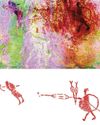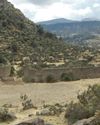
The story of urbanism traditionally begins in what is today southern Iraq. There, around 5,500 years ago, the Sumerian settlement of Uruk developed on the banks of the Euphrates River. At its peak, some 50,000 people, including nobles, artisans, merchants, and slaves, are thought to have lived within the city’s mudbrick walls, which enclosed two square miles. This large urban population existed thanks in part to an agricultural surplus managed by a centralized bureaucracy that tracked economic transactions on cuneiform tablets. But a few hundred years before Uruk emerged, some 1,700 miles to the northwest in the forest-steppe of central Ukraine, farmers with no written language were already living in settlements so large they sprawled over an area up to 1.5 square miles, and were home to perhaps as many as 20,000 people. In age and size, these so-called Trypillia megasites rivaled the earliest cities of Mesopotamia. But that’s where the similarities end.
While imposing central temple complexes anchored cities such as Uruk, a typical Trypillia megasite featured an empty space in the middle surrounded by thousands of identical homes arranged in oblong concentric rings. Archaeologists believe that the farmers who lived in these huge settlements thrived without rulers, without monuments, and without wealth disparities, all elements that were present at Uruk and other early cities. “We’re sure that they’re not cities in a classic sense,” says John Chapman, a Durham University archaeologist. “They’re probably egalitarian, but that sort of idea is really new to urban studies. Whoever heard of an urban center that’s not run by a strong hierarchy?” Understanding these contradictions offers a real challenge for archaeologists working at Trypillia sites.
This story is from the May/June 2020 edition of Archaeology.
Start your 7-day Magzter GOLD free trial to access thousands of curated premium stories, and 8,500+ magazines and newspapers.
Already a subscriber ? Sign In
This story is from the May/June 2020 edition of Archaeology.
Start your 7-day Magzter GOLD free trial to access thousands of curated premium stories, and 8,500+ magazines and newspapers.
Already a subscriber? Sign In

A Very Close Encounter
New research has shown that human figures painted in red on a rock art panel in central Montana depict individuals engaged in a life-or-death encounter during an especially fraught historical moment.

A Sword for the Ages
A zigzag pattern, now tinged with the green-blue patina of oxidized metal, adorns the octagonal hilt of a rare sword dating to the Middle Bronze Age in Germany (1600-1200 B.C.) that was recently excavated in the Bavarian town of Nördlingen.

Ancient Egyptian Astrology
For centuries, layers of soot have coated the ceilings and columns in the entrance hall of Egypt's Temple of Esna. Now, an Egyptian-German team of researchers, led by Hisham El-Leithy of the Egyptian Ministry of Tourism and Antiquities and Christian Leitz of the University of Tübingen, is restoring the temple's vibrant painted reliefs to their original brilliance.

BRONZE AGE POWER PLAYERS
How Hittite kings forged diplomatic ties with a shadowy Greek city-state

RITES OF REBELLION
Archaeologists unearth evidence of a 500-year-old resistance movement high in the Andes

Secrets of Egypt's Golden Boy
CT scans offer researchers a virtual look deep inside a mummy's coffin

When Lions Were King
Across the ancient world, people adopted the big cats as sacred symbols of power and protection

UKRAINE'S LOST CAPITAL
In 1708, Peter the Great destroyed Baturyn, a bastion of Cossack independence and culture

LAPAKAHI VILLAGE, HAWAII
Standing beside a cove on the northwest coast of the island of Hawaii, the fishing village of Lapakahi, which is surrounded by black lava stone walls, was once home to generations of fishers and farmers known throughout the archipelago for their mastery of la'au lapa'au, or the practice of traditional Hawaiian medicine. \"

A MORE COMFORTABLE RIDE
Although the date is much debated, most scholars believe people 5,000 years ago. For thousands of years after that, they did so without saddles. \"In comparison with horse riding, the development of saddles began relatively late, when riders began to care more about comfort and safety in addition to the horse's health,\" says University of Zurich archaeologist Patrick Wertmann.